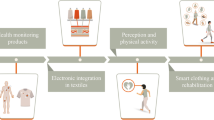Abstract
The contribution presents an approach for motion capturing (MoCap) of dressed people. A cloth draping method is embedded in a silhouette based MoCap system and an error functional is formalized to minimize image errors with respect to silhouettes, pose and kinematic chain parameters, the cloth draping components and external wind forces. We report on various experiments with two types of clothes, namely a skirt and a pair of shorts. Finally we compare the angles of the MoCap system with results from a commercially available marker based tracking system. The experiments show, that we are basically within the error range of marker based tracking systems, though body parts are occluded with cloth.
We gratefully acknowledge funding by the Max-Planck Center for visual computing and communication.
Preview
Unable to display preview. Download preview PDF.
Similar content being viewed by others
References
Bregler, C., Malik, J., Pullen, K.: Twist based acquisition and tracking of animal and human kinetics. International Journal of Computer Vision 56(3), 179–194 (2004)
Brox, T., Rousson, M., Deriche, R., Weickert, J.: Unsupervised Segmentation Incorporating Colour, Texture, and Motion. In: Petkov, N., Westenberg, M.A. (eds.) CAIP 2003. LNCS, vol. 2756, pp. 353–360. Springer, Heidelberg (2003)
Dervieux, A., Thomasset, F.: A finite element method for the simulation of Rayleigh–Taylor instability. In: Rautman, R. (ed.) Approximation Methods for Navier–Stokes Problems. Lecture Notes in Mathematics, vol. 771, pp. 145–158. Springer, Berlin (1979)
Fua, P., Plänkers, R., Thalmann, D.: Tracking and modeling people in video sequences. Computer Vision and Image Understanding 81(3), 285–302 (2001)
Gavrilla, D.M.: The visual analysis of human movement: A survey. Computer Vision and Image Understanding 73(1), 82–92 (1999)
Haddon, J., Forsyth, D., Parks, D.: The appearance of clothing (June 2005), http://http.cs.berkeley.edu/haddon/clothingshade.ps
Herda, L., Urtasun, R., Fua, P.: Hierarchical Implicit Surface Joint Limits to Constrain Video-Based Motion Capture. In: Pajdla, T., Matas, J(G.) (eds.) ECCV 2004. LNCS, vol. 3022, pp. 405–418. Springer, Heidelberg (2004)
House, D.H., DeVaul, R.W., Breen, D.E.: Towards simulating cloth dynamics using interacting particles. Clothing Science and Technology 8(3), 75–94 (1996)
Magnenat-Thalmann, N., Volino, P.: From early draping to haute cotoure models: 20 years of research. Visual Computing 21, 506–519 (2005)
Mikic, I., Trivedi, M., Hunter, E., Cosman, P.: Human body model acquisition and tracking using voxel data. International Journal of Computer Vision 53(3), 199–223 (2003)
MoCap-System. Motion analysis: A marker based tracking system (June 2005), http://www.motionanalysis.com
Moeslund, T.B., Granum, E.: A survey of computer vision based human motion capture. Computer Vision and Image Understanding 81(3), 231–268 (2001)
Murray, R.M., Li, Z., Sastry, S.S.: Mathematical Introduction to Robotic Manipulation. CRC Press, Baton Rouge (1994)
Osher, S., Sethian, J.A.: Fronts propagating with curvature-dependent speed: Algorithms based on Hamilton–Jacobi formulations. Computational Physics 79, 12–49 (1988)
Richards, J.: The measurement of human motion: A comparison of commercially available systems. Human Movement Science 18, 589–602 (1999)
Rosenhahn, B., Kersting, U.G., Smith, A.W., Gurney, J.K., Brox, T., Klette, R.: A System for Marker-Less Human Motion Estimation. In: Kropatsch, W.G., Sablatnig, R., Hanbury, A. (eds.) DAGM 2005. LNCS, vol. 3663, pp. 230–237. Springer, Heidelberg (2005)
Weil, J.: The synthesis of cloth objects. Computer Graphics (Proc. SigGraph) 20(4), 49–54 (1986)
Author information
Authors and Affiliations
Editor information
Editors and Affiliations
Rights and permissions
Copyright information
© 2006 Springer-Verlag Berlin Heidelberg
About this paper
Cite this paper
Rosenhahn, B., Kersting, U.G., Powell, K., Seidel, HP. (2006). Cloth X-Ray: MoCap of People Wearing Textiles. In: Franke, K., Müller, KR., Nickolay, B., Schäfer, R. (eds) Pattern Recognition. DAGM 2006. Lecture Notes in Computer Science, vol 4174. Springer, Berlin, Heidelberg. https://doi.org/10.1007/11861898_50
Download citation
DOI: https://doi.org/10.1007/11861898_50
Publisher Name: Springer, Berlin, Heidelberg
Print ISBN: 978-3-540-44412-1
Online ISBN: 978-3-540-44414-5
eBook Packages: Computer ScienceComputer Science (R0)




